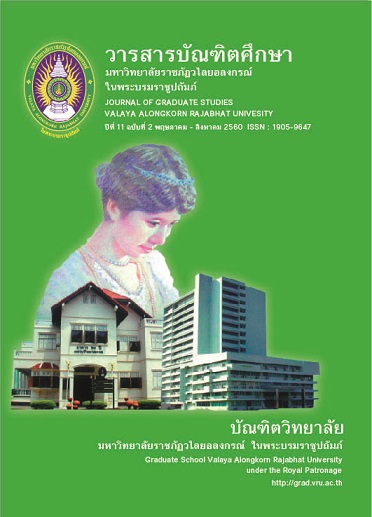ผลกระทบความเสี่ยงจากคนและทุนมนุษย์ต่อผลิตภาพแรงงานในการลงทุนทางตรงจากต่างประเทศในประเทศไทย
Main Article Content
Abstract
บทคัดย่อ
ในการศึกษาครั้งนี้มีวัตถุประสงค์เพื่อพัฒนาตัวแบบผลกระทบความเสี่ยงจากคนและทุนมนุษย์ต่อผลิตภาพแรงงาน และเพื่อทดสอบผลกระทบความเสี่ยงจากคนและทุนมนุษย์ต่อผลิตภาพแรงงานของบริษัทข้ามชาติที่เข้ามาลงทุนทางตรงในประเทศไทย ผู้วิจัยดำเนินการวิจัยเชิงปริมาณในระดับบริษัท จากกลุ่มตัวอย่างที่เป็นผู้บริหารระดับสูงชาวต่างชาติจำนวน 433 ตัวอย่าง สถิติที่ใช้ในการวิเคราะห์ข้อมูล คือการวิเคราะห์องค์ประกอบเชิงยืนยัน และการวิเคราะห์โมเดลสมการโครงสร้าง
ผลการวิเคราะห์โมเดลสมการโครงสร้าง วัตถุประสงค์ที่ (1) เพื่อพัฒนาตัวแบบผลกระทบความเสี่ยงจากคนและทุนมนุษย์ต่อผลิตภาพแรงงานของบริษัทข้ามชาติที่เข้ามาลงทุนทางตรงในประเทศไทย โดยการศึกษาปัจจัยดังต่อไปนี้ เพื่อศึกษาปัจจัยที่มีอิทธิพลต่อผลิตภาพแรงงาน อันได้แก่ลักษณะขององค์กร และความเสี่ยงจากคนและทุนมนุษย์ ผลการวิเคราะห์โมเดลสมการโครงสร้าง พบว่าลักษณะขององค์กรมีอิทธิพลทางบวกอย่างมีนัยสำคัญต่อผลิตภาพแรงงานโดยมีค่าสัมประสิทธ์เส้นทางเท่ากับ 0.807 และความเสี่ยงจากคนและทุนมนุษย์มีอิทธิพลทางลบอย่างมีนัยสำคัญต่อผลิตภาพแรงงานโดยมีค่าสัมประสิทธ์เส้นทางเท่ากับ -0.387 วัตถุประสงค์ที่ (2) เพื่อทดสอบผลกระทบความเสี่ยงจากคนและทุนมนุษย์ต่อผลิตภาพแรงงาน
ผลการวิจัยพบว่า โมเดลสมการโครงสร้างที่ปรับใหม่ (Modified Model) สอดคล้องกับข้อมูลเชิงประจักษ์ แสดงว่ายอมรับสมมติฐานหลักที่ว่า โมเดลตามทฤษฎีสอดคล้องกลมกลืนกับข้อมูลเชิงประจักษ์ ทั้งนี้พิจารณาจาก ค่าสถิติไคว์-สแควร์ () มีค่าเท่ากับ 46.592 ค่าองศาอิสระ (df) มีค่าเท่ากับ 39 ความ p-value มีค่าเท่ากับ 0.188 ค่าสถิติไคว์-สแควร์สัมพัท (
/df) มีค่าเท่ากับ 1.195 เมื่อพิจารณาค่าความสอดคล้องจากดัชนีวัดระดับความกลมกลืน (GFI) มีค่าเท่ากับ 0.982 ค่า AGFI มีค่าเท่ากับ 0.964 และค่า RMSEA มีค่าเท่ากับ 0.021
ABSTRACT
The purpose of this study is to develop an effect of people and human capital risk to labour productivity and to examine an effect of people and human capital risk to labour productivity in the multinational company which directly invests in Thailand. The researcher conducts quantitative research in the company level from 433 samples of foreign senior executives. The statistical methods for analyzing data are confirmatory factor analysis and Structural Equation Modeling analysis.
The result of Structural Equation Modeling analysis Objective (1) To develop the model of people and human capital risk impact on labour productivity in the multinational company which direct investment in Thailand by study the following factors to find influencing factors on labor productivity including organization characteristic and people and human capital risk.
The analysis result of Structural Equation Modeling shows that the organization characteristic has significantly positive influence on labour productivity with the path coefficient value is 0.807 and people and human capital risk has significantly negative influence on labour productivity with the path coefficient value is -0.387. Objective (2) to examine the people and human capital risk impact on labor productivity. The research result funds that the Modified Structural Equation Model is valid and well fitted to empirical data. This satisfies main hypothesis that is the theoretical model in harmony with empirical data considering Chi-Square (Article Details

This work is licensed under a Creative Commons Attribution-NonCommercial-NoDerivatives 4.0 International License.
บทความทุกเรื่องได้รับการตรวจความถูกต้องทางวิชาการโดยผู้ทรงคุณวุฒิ ทรรศนะและข้อคิดเห็นในบทความ Journal of Global of Perspectives in Humanities and Social Sciences (J-GPHSS) มิใช่เป็นทรรศนะและความคิดของผู้จัดทำจึงมิใช่ความรับผิดชอบของบัณฑิตวิทยาลัย มหาวิทยาลัยราชภัฏวไลยอลงกรณ์ ในพระบรมราชูปถัมภ์ กองบรรณาธิการไม่สงวนสิทธิ์การคัดลอก แต่ให้อ้างอิงแหล่งที่มา


